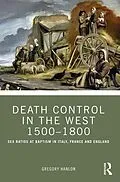Employing a rigorous methodological approach and analysing a vast body of sources from towns and regions in Italy, France and England over 300 years, this book hints at the extent of "routine" infanticide of newborns by married parents in early modern Europe, a practice ignored by contemporary tribunals.
Death Control in the West 1500-1800 examines baptismal registers and ecclesiastical censuses across a score of communities in Catholic and Protestant Europe. Married women had little reason to hide their condition from priests, midwives, neighbours and friends; however, the practice of post-partum abortion was common everywhere, especially during times of hardship. By no means was it confined to the lower classes or to girls alone. Proposing a series of reflections on population control, this volume explores how families adopted a system of selective infanticide to manage resources and to safeguard social status, just like populations elsewhere around the globe.
This study is an excellent tool for students and researchers interested in the demographic mechanisms of the age and social and familial relationships in early modern Europe.
Autorentext
Gregory Hanlon is George Munro Chair in History at Dalhousie University, Canada. He is a French-trained behavioural historian of early modern Europe, author of ten books to date on disparate themes. Two ground-breaking titles relevant here are Community and Confessions in Seventeenth-Century France (1993), Human Nature in Rural Tuscany (2003).
Inhalt
Introduction: Grim reckonings from European archives Part One: Italy 1. Introduction to Italian demography after the Council of Trent 2. Montefollonico: Infanticide by married couples in early modern Tuscany 3. Torrita di Siena 1580-1770, or the high cost of cheap food 4. Pavia (Lombardy) 1576-1700: the importance of neighbourhood 5. Parma (Emilia) 1500-1800: Girls before boys 6. Mountain demography during the Little Ice Age (Emilia) 7. Three Piacentino towns: Cortemaggiore, Fiorenzuola, Castel San Giovanni (Emilia): a terrible synchrony Part Two: Southwestern France 8. Introduction to Aquitaine during the seventeenth and eighteenth centuries 9. Agen: Aquitaine's complicated second city 1600-1715 10. Villeneuve-sur-Lot: two parishes and one destiny 1610-17ll 11. Marmande 1605-1711: a small town during the Iron Century 12. Mézin 1649-1743: Gascon rural demography in the Classical Age 13. Layrac 1628-1711: a typical confessionally mixed community 14. Nérac 1623-1731: a Huguenot bastion in Gascony 15. Bergerac in Perigord 1653-1718: Protestants and Catholics in a hungry land Part Three: England 16. Infanticide and unexceptional sex ratios in England 1550-1750 17. Leeds: the sprawling workshop of Western Yorkshire 1588-1734 18. Dorchester 1654-1737: an idyllic county seat from Oliver Cromwell to George II Conclusion: a road-map for further exploration
